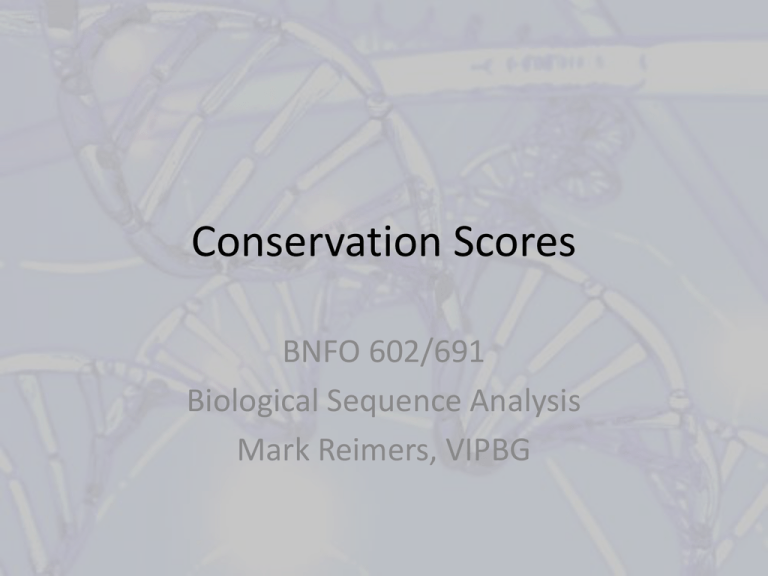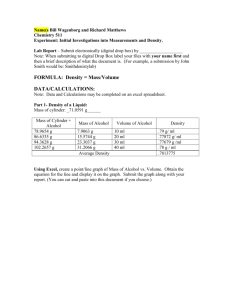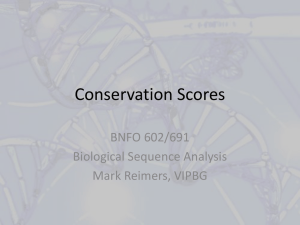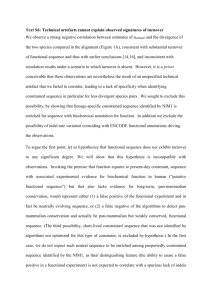Conservation scores
advertisement

Conservation Scores BNFO 602/691 Biological Sequence Analysis Mark Reimers, VIPBG Conservation and Function: what kinds of DNA regions get conserved? • Core coding regions are usually conserved across hundreds of millions of years (Myr) • Active sites of enzymes and crucial structural elements of proteins are highly conserved • Untranslated regions of genes are conserved over tens but not over hundreds of Myr • Some regulatory regions evolve ‘quickly’ – over a time scale of tens of Myr Conservation and Function: what kinds of DNA regions get conserved? • Many splice sites and splice regulators are conserved between mouse and human • Most promoters (70%) conserved between mouse and human • Majority (~70%) of enhancers not conserved, but a significant minority are highly conserved Approaches to Scoring Conservation • • • • Base-wise: PhyloP, GERP Small regions: PhastCons Small regions, tracking bias: SiPhy Regulatory conservation within exons may be detected by any of these methods • Key regulatory regions are harder to see DEMO: UCSC Alignment & Conservation Tracks Genomic Alignment • Alignment is crucial (and not trivial) – Common alignment algorithms may misplace ambiguous bases, leading to artifactual gaps – Inversions are often badly handled • Issue: incomplete alignments are not reflected in scores of any current algorithm – Conservation scores computed on aligned genomes only • Alignments of 46 placental mammals to human genome in MultiZ format at UCSC – Subset of primate alignments also Alignment Issues • When studying protein-coding regions, substitutions are most common • Most genome evolution happens through insertions or deletions – Human chimp alignable genome is 97% identical – Only 91% of genome is alignable • Regions may acquire regulatory function in some lineages but have no function in most UCSC Alignment Symbols • Single line ‘-’: No bases in the aligned species. – May reflect insertion in the human genome or deletion in the aligning species. • Double line ‘=‘: Aligning species has unalignable bases in the gap region. – Many mutations or independent indels in between the aligned blocks in both species. • Pale yellow coloring: Aligning species has Ns in the gap region. – Sequencing problems in aligning species Conservation Across Mammals Differs from Conservation Across Primates • Many regions conserved across mammals are also conserved across primates – a few appear not to be • Some regions appear to be conserved (insofar as can be measured) in primates but not across all mammals • What is the diagonal? Are these regions conserved? Genomic Evolutionary Rate Profiling (GERP) Measures Base Conservation • Estimates mean number of substitutions in each aligned genome to estimate neutral evolution rate • Original score is “rejected substitutions”: the number of substitutions expected under ‘neutrality’ minus the number of substitutions observed at each aligned position • New scores based on ML fit of substitution rate at base • Positive scores (fewer than expected) indicate that a site is under evolutionary constraint. – Negative scores may be weak evidence of accelerated rates of evolution PhyloP Assigns Conservation P-values • Estimates mean number of substitutions in each aligned genome to estimate neutral evolution rate estimated from non-coding data (conservative) • Compares probability of observed substitutions under hypothesis of neutral evolutionary rate • Scores reflect either conservation (positive scores) or selection (negative scores) • Score defined as –log10(P) where P is p-value for test of number of substitutions following (uniform) neutral rate inferred from all sites in alignment NB PhyloP may also refer to a suite of tools PhastCons Fits a Hidden Markov Model • PhastCons fits HMM with states ‘conserved’ and ‘not conserved’ • Neutral substitution rates estimated from data as for PhyloP • Tunable parameter m represents inverse of expected length of ‘conserved’ regions • Parameter n sets proportion of conserved Siepel A et al. Genome Res. regions 2005;15:1034-1050 PhastCons Fits a Hidden Markov Model • Scaling parameter ρ (0 ≤ ρ ≤ 1) represents the average rate of substitution in conserved regions relative to average rate in nonconserved regions and is estimated from data • Originally developed to detect moderate-sized sequences such as non-coding RNA • Can be adapted to shorter sequences but not as powerful SiPhy • SiPhy models the pattern of substitutions, rather than just the rate, as do most others. – Biased substitutions (e.g. conserved lysine: AAA <-> AAG only) will be identified as constrained – Some TFBS have similar degeneracy in evolution – This is a more refined approach than rate models, but requires a fairly deep (or wide) phylogeny • SiPhy uses a Bayesian approach and needs two parameters like PhastCons: the fraction of sequence conserved, and the typical length of a conserved region. SiPhy Applied to Mammalian Genomes Identification of four NRSF-binding sites in NPAS4. K Lindblad-Toh et al. Nature (2011) Comparison of Methods • PhyloP, PhastCons, and GERP give fairly similar results over deep phylogenies (e.g. vertebrates) • Differ substantially over bushes (e.g. primates) • SiPhy is more sensitive over moderately deep phylogenies (e.g. mammals) – Cannot be implemented for primates because of insufficient substitutions Issues With Conservation Scores • Most scores are misleading about gaps in alignments: they don’t distinguish between contig gaps (incomplete genomes) and inserted or deleted regions – This information is often available but inconvenient to use • Each model was devised with a particular kind of conservation in mind, and may not be adaptable to all kinds • Broken sequences – e.g. ZNF TFBS are not captured well by any current method











